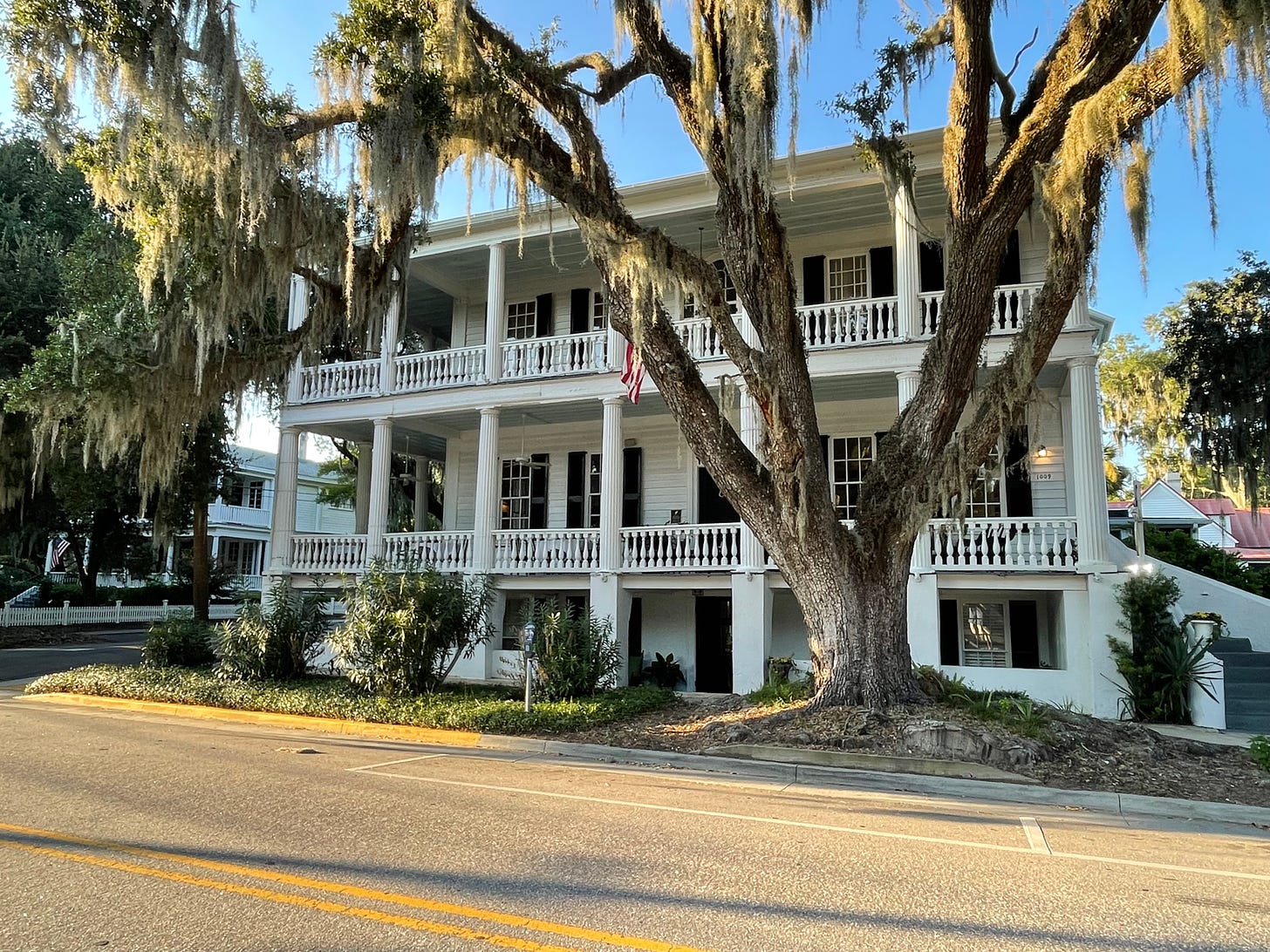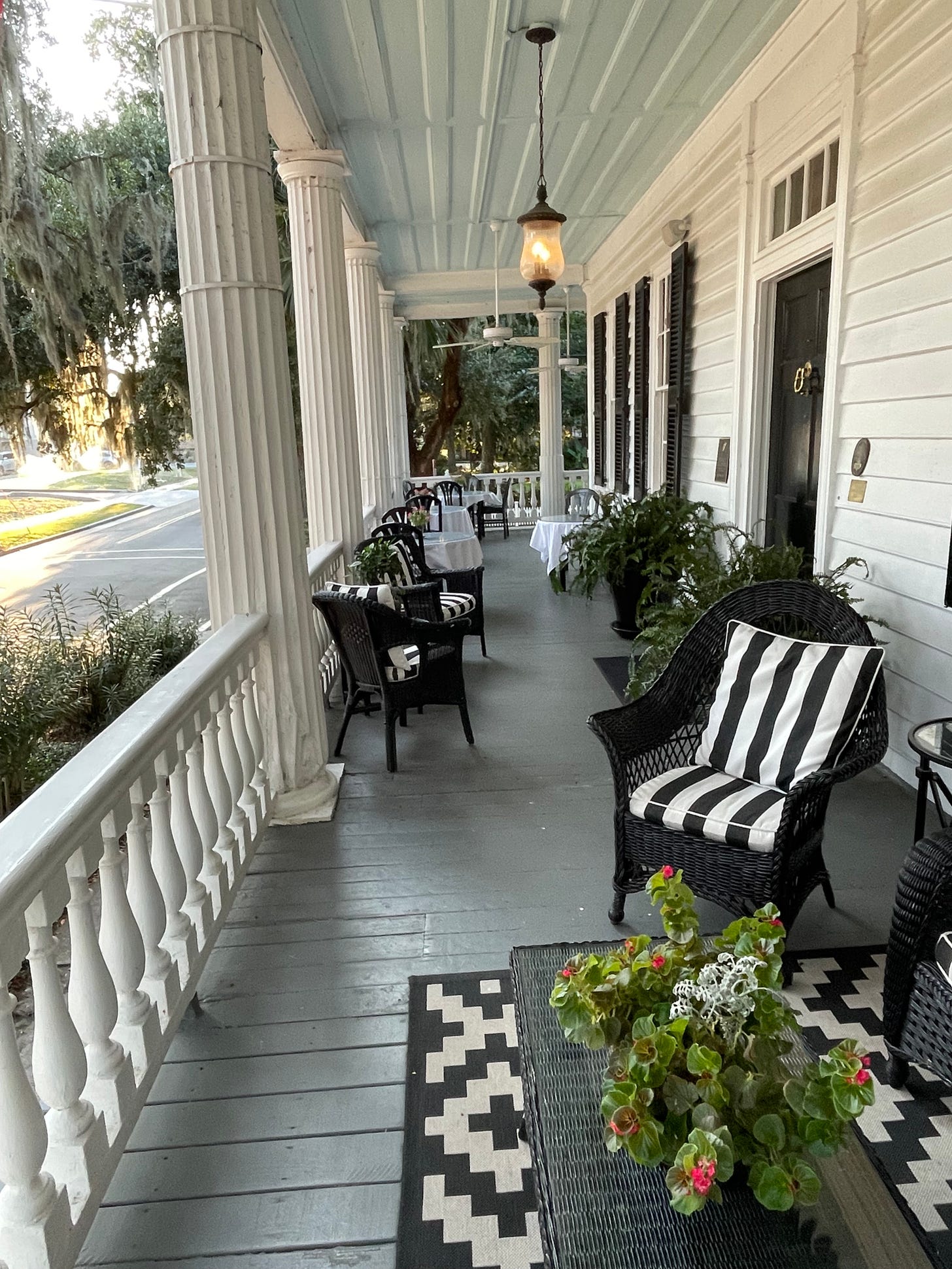Last week I made my headquarters at the beautiful Rhett House Inn in Beaufort, South Carolina from where I explored the low country between James Island, SC and St. Simons Island, Georgia. The Rhett House Inn is one of a number of antebellum homes in Beaufort that have been turned into charming hotels for tourists.
According to their website, the Rhett House was built around 1820 and is described as an “in-town plantation house.” The website notes some of the architectural and design characteristics of the home. I learned that the cottage structure in the rear of the home was built in 1846 and was used “as a store for freed slaves to buy and sell goods.” During the Civil War, the home was utilized as a hospital for Union soldiers.
The reference to the home as an “in-town plantation house” is the closest one will get to connecting the home and its originial owners to the history of slavery. That, of course, is intentional and has a history stretching back to the turn of the twentieth century, when white northerners traveled south looking for reminders of the “Old South.”
New highways and improved roads, access to trains, the affordability of the Model-T, and a population looking to escape from a quickly expanding urban-industrial landscape facilitated this rise in tourism.
According to historian Karen Cox:
Tourism has played an important role in the development of the South’s cultural identity. It has helped both outsiders and native southerners to define the region. Nineteenth-century writers often linked southern culture to its landscape, especially its plantations, but also to its flora and fauna and other natural features. (p. 131)
And historian Nina Silber has noted:
No longer preoccupied with wartime anguish and destruction, northerners of the post-Reconstruction years increasingly thought of the South in tourist terms, as a land of leisure, relaxation, and romance. [Tourism] and reconciliation went hand in hand, as hands wer often literally joined together in much of the literature which promoted an explicitly romantic notion of North-South reunion. (p. 67)
This romanticized and highly sterilized depiction of the antebellum South left no room to recall the horrors of slavery. Instead, slavery and race relations were remembered as peaceful and benign in the popular Lost Cause narrative of the day.
I had to remind myself, in between breakfast on the veranda and late night conversations with guests in the front parlor room from around the country and beyond, that my presence as a guest in the Rhett House was part of this history described by Cox and Silber.
In short, we were all taking part in a story that began as an elaborate fantasy.
The 1860 U.S. Census Slave Schedules for Beaufort County indicates a total of 32,530 slaves, ranking it the second highest County total in the U.S., behind Charleston. Keep in mind that this was the slave count for the county and does not include enslaved people working on plantations elsewhere and owned by the families living in Beaufort.
This includes the owner of the Rhett House, who owned a plantation along the Ashepoo River before the Civil War.
As a historian with a deep interest in the history and memory of slavery and the South, I couldn’t help but see the product of their toil everywhere I turned as I walked the streets of Beaufort. It is easy to lose sight of the fact that none of this would be possible without the institution of slavery as you appreciate the tall live oaks, draped with spanish moss, that bring shade to the many large colorful estates and gardens throughout this historic neighborhood.
It is even more problematic if you don’t know to look for it at all.
Let me be clear. I am not suggesting that tourists shouldn’t stay in these historic homes. I had a wonderful visit. The staff was very friendly; the food was delicious; my room was comfortable; and I really enjoyed the opportunity to talk with other visitors. If I have the opportunity, I will stay there again.
But I do believe that the owners of these homes need to find ways to remind their visitors that they are sleeping under the roofs that enslaved people were forced to build or whose labor made their construction possible.
I don’t think that this is a history that needs to be hidden in these homes. I think it can be done in ways that don’t alienate visitors or make them feel unnecessarily uncomfortable, but actually helps them connect more deeply to where they have chosen to stay. As I have already written, I was impressed with the ways in which the history of slavery is now discussed throughout Beaufort and the surrounding area.
Perhaps one approach would be to name certain rooms in honor of enslaved men, women, and children that can be identified. How about bringing in a local historian or even National Park Service ranger to talk about the history of slavery in the community?
I have no doubt that visitors will sleep just as well and their late afternoon coffee on the veranda will be just as relaxing having learned this important piece of American history.






A difficult issue, as you say. And the Rhetts were leading secessionists, too - though Unionists in the SC "insane asylum" would have been hard to find. I've looked at a lot of historic buildings - such as the White House and the Capitol - differently since I realized the role of enslaved labor in building them.
Perhaps all historic makers should state at the beginning, “Built by enslaved persons in [dates] owned by...” We could start with the White House and the Capital, as MSB points out. Certainly needed at the homes of many of the presidents.
Other markers might state, “Built by enslaved Native Americans...”